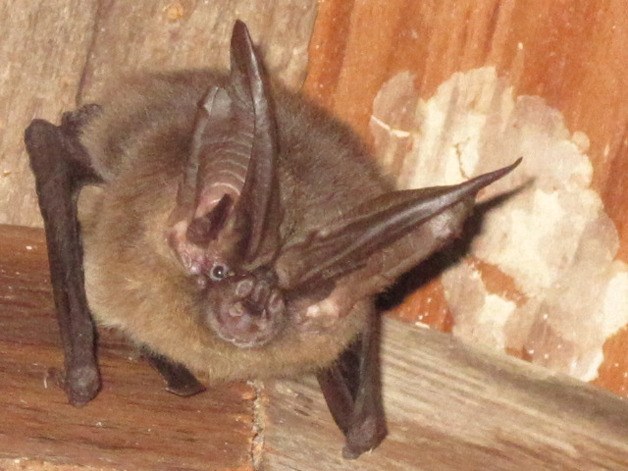By Liz Needham
Special to the Sounder
Bats are some of the least studied animals, and much of their lives remain a mystery. Very little is known about the abundance of bats in the San Juan Islands, and researchers don’t really know if bat populations are healthy. For this reason, Kwiáht, a nonprofit scientific organization run by islanders and based on Lopez, has launched a “Lopez Island Baseline Bat Status Assessment.” The Status Assessment will map out where Lopez bats live and estimate population numbers to use as a baseline for future research.
In the spring of 2010, Kwiáht helped Moran State Park design and construct a demonstration “bat tower” for relocating a large maternity colony of rare Long-eared Myotis from the park manager’s office. Russel Barsh, Kwiáht’s director, describes a bat tower as “like a small toolshed on stilts, closed except for narrow slits for bats to use, with rafters and a shingle roof that bats find attractive for roosting.”
Why like bats?
“If you are a gardener, farmer or don’t like being bitten by mosquitos, you should encourage lots of local bats to live nearby,” said Shona Aitkin, education coordinator at Wolf Hollow Wildlife Rehab Center.
Our neighborhood bats are amazing little animals.
“The only mammals that can fly under their own power, bats play crucial roles in ecosystems worldwide, including being pollinators,” said Barsh. “In the Pacific Northwest, all of our bats are insectivores, and eat many pests such as mosquitoes, termites, and moths. One small bat that weighs less than an ounce can eat hundreds of flying insects in an hour.”
Orcas Islanders Bill and Susan Fletcher of Turtleback Farms have enjoyed local bats for many years.
“We like bats!” Bill said. “We think they’re beneficial and no trouble … When we’re eating out at night, we can watch them soaring around, and we appreciate them. If I were an insect I wouldn’t like them. But I’m not an insect, so I like them… Yeah, I think they’re super critters.”
Threats to bats
According to Barsh, the main threats to bats in the islands are associated with humans: clearing woodlands, cutting down old trees with cavity nests, tearing down or burning decaying old buildings, re-roofing or re-siding buildings where bats are living in the attic or walls. Cats and rats also kill bats near the homes they share with humans.
Growing regional interest in wind power raises concerns for bats in the islands. Large-scale wind energy production uses very large rotors that can attain speeds of more than 200 miles per hour – strangely attractive to bats, and too fast for bats to avoid. Migrating bats such as Hoary and Silver-haired bats are most at risk, but researchers do not see evidence of large-scale migrations in the islands. Smaller rotors designed to supply electricity to one, or a few households, do not seem to pose the same risks as commercial scale turbines, and they can easily be shut down during the few hours of dusk and dawn when bats are most actively flying and foraging.
Facts about bats
At least five species of tiny mouse-eared bats in the genus Myotis, such as the Little Brown, make the islands their home. Mouse-eared bats look similar from a distance and use the same frequencies to navigate and target their prey, but they vary somewhat in body proportions and behavior. Two local mouse-eared species are actually quite rare. There are also several larger bats: Townsend’s Big-Eared, Silver-Haired, Hoary, and Big Brown.
Bat species divide the night, hunting at different times and focusing on different kinds of insects. Big Browns are fond of beetles, for example, while Townsend’s bats think moths are divine. Bats eavesdrop on insects’ own high frequency broadcasts to locate, identify, and track them.
Bats typically mate in the fall and give birth in early summer, but female bats can slow their pregnancies until there is adequate food to support nursing. Individuals of some species have been recorded to live to over 30 years of age!
Barsh says that most of the island bat colonies he’s visited are occupied year-round by at least some of the bats. Many island bats appear to abandon summer colonies in the winter, and to reduce their activity during wet or freezing weather, but do not appear to stay in sleepy “torpor” for long periods of time or to leave.
Barsh said we should use the same common-sense precautions with bats that apply to all wildlife. Never approach or handle a wild animal; if you see a bat that could be injured or sick, call Wolf Hollow Wildlife at 378-5000. For info on how to exclude bats from human spaces and safely clean up droppings, go to http://wdfw.wa.gov/living/bats.html.For info on bats and public health go to www.batsnorthwest.org/bats_my_health.html.
If you have bat info or stories, call or email elizabethneedham@hotmail.com or 509-969-0664. You can read more about bats at www.batcon.org and www.batsnorthwest.org.
Liz Needham is the Bat Survey Coordinator for Kwiáht.




